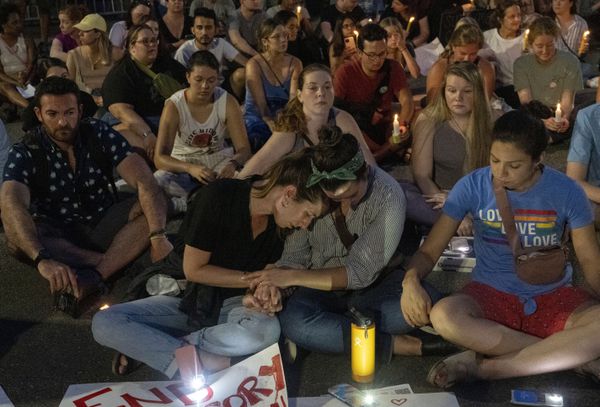:format(jpeg)/cloudfront-us-east-1.images.arcpublishing.com/tgam/CQJIX3BUMZKBTONOASZATYHBRE.jpg)
Abortion-rights protesters participate in a candlelight vigil for reproductive freedom and abortion rights outside the U.S. Supreme Court in Washington on June 26, 2022.Gemunu Amarasinghe/The Associated Press
Maxwell Mak is associate professor of political science at John Jay College of Criminal Justice. Andrew Sidman is professor and chair of political science at John Jay College of Criminal Justice.
In Dobbs v. Jackson Women’s Health Organization, the U.S. Supreme Court upheld the constitutionality of Mississippi’s law banning abortions after the 15th week of pregnancy. Justice Samuel Alito, writing for the majority, explicitly overturned Roe v. Wade and Planned Parenthood v. Casey. As a result, women in the United States no longer have a federally protected right to seek and obtain an abortion.
Much attention is being given to Justice Clarence Thomas’s concurring opinion, in which he suggests the court reconsider previous cases such as Griswold v. Connecticut (establishing the right to privacy and protecting contraception), Lawrence v. Texas (protecting same-sex intimacy), and Obergefell v. Hodges (protecting same-sex marriage). Those rulings were created by courts through substantive due process, a legal principle favouring the protection of fundamental rights not explicitly written in the U.S. Constitution.
Where the majority opinion argues that Dobbs’ legal reasoning should only apply to abortion, Justice Thomas’s concurrence invites future legal challenges to rights not written in the Constitution. One could argue that the concurrence was only signed by himself and so shouldn’t be a cause of concern, but it will surely reach some lower court judges willing to adopt his arguments and embolden conservative activists to do the same.
So are prior decisions that use substantive due process such as Griswold, Lawrence, and Obergefell likely to be overturned? Most likely no. Justice Brett Kavanaugh, who also wrote a concurrence, signaled that any expansion of Dobbs’ reasonings beyond abortion would not be supported. Moreover, Chief Justice John Roberts wanted a more measured approach than removing the right to abortion altogether. Without these two justices, the votes simply are not there to overturn these important precedents.
The rights enshrined in them are, however, more likely to be threatened or weakened in the coming months or years as a result of the “history and traditions” framework used by the Supreme Court in Dobbs and in other recent cases, including faith-based objections from bakers and foster care and adoption agencies wanting to deny services to gay and lesbian clients. The court in those instances based their decisions on particular facts of the cases, and did not answer the question of just how far those religious objections are protected.
The “history and traditions” lens leaves it up to judges and justices to determine whether a right is “deeply rooted in this nation’s history and tradition” whenever it is not written in the Constitution; what falls within the definitions is solely at the discretion of the justices hearing these cases. In their dissent, Justices Stephen Breyer, Sonia Sotomayor, and Elena Kagan rightly criticize the subjective and biased ways that “history” can be used as a basis for making decisions.
With Roe now gone, conservative activists will be empowered to challenge other freedoms, and the next logical step would be for such legal entrepreneurs to challenge protections based on the right to privacy such as reproductive health and contraception. While a complete ban on birth control may seem far-fetched, some states will attempt to limit access to contraception or ban certain types of contraceptives. Americans could see bans on IUDs, emergency contraception, and other types of birth control conservatives view as abortion-adjacent.
While gay rights cases such as Lawrence and Obergefell tend to invoke additional protections from the Equal Protection Clause in the 14th Amendment (which forbids discrimination) – meaning that same-sex intimacy and marriage equality are arguably more secure – both LGBTQ and reproductive rights will also be weakened by continued extensions of the current Supreme Court’s support of religious freedoms.
And what should concern activists the most is the way legal reasoning has been so easily co-opted by ideology. In Dobbs, the court argues that states should have the ability to regulate abortion. In a majority opinion handed down the day before, the court argued that states cannot be trusted to safeguard the Second Amendment’s right to bear arms.
Many will point out the irony of these contradictory statements. The reality, however, is that this Supreme Court is less concerned about the consistency of the arguments it advances and is more focused on having the law reflect their political preferences, even if the justifications are muddied or appear to be contradictory.
With a closely divided Congress and an uncertain outlook in upcoming elections, there is little that can be done now to reform or rein in the court. In the months and years to come, we should expect many legal battles over privacy-based rights that were previously safe.
Keep your Opinions sharp and informed. Get the Opinion newsletter. Sign up today.







